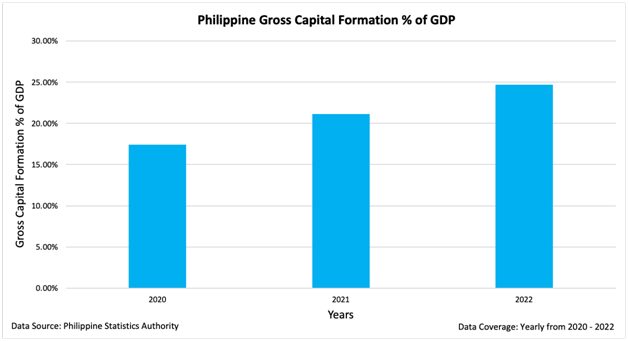PH Monday Macro: The benefits and concerns of the Maharlika Investment Fund

Our last report explained the Philippines’ first possible national wealth fund, the Maharlika Investment Fund (MIF). We outlined its objectives, funding, and its array of possible investments.
Despite the economic benefits of the sovereign fund, there are critiques and concerns with having a national investment fund.
Today, we will discuss the economic benefits and concerns of the Maharlika Investment Fund.
Philippine Markets Daily:
The Monday Macro Report
Powered by Valens Research
According to the economic theory of capital accumulation, increased investment leads to higher levels of productivity and output, which in turn contributes to long-term economic growth. This is what the Philippine government hopes the MIF to be—an avenue for capital formation in the economy.
The fund accumulates a substantial capital base by pooling financial resources from government-owned and controlled corporations (GOCCs) and other sources. This capital can be channeled into various projects to stimulate economic activities and drive economic growth.

One way it can develop the economy is through investments in infrastructure projects and companies–with such investments generating employment opportunities. As companies expand their operations and invest in new ventures, the demand for labor will increase. As a result, not only will it reduce unemployment, but it will also enhance income levels, which will improve living standards.
Moreover, unlike traditional investment funds, the MIF’s broader scope of investments in areas such as health, education, research, and innovation has positive externalities. These can enhance economic productivity and innovation, leading to long-term economic gains and improved welfare.
However, the utilization of national surpluses for the MIF raises concerns about the government’s ability to effectively allocate resources.
Critics argue that instead of creating a new investment fund, the government should focus on improving existing frameworks and ensuring efficient utilization of funds aligned with the country’s development goals.
Another concern of having a national fund is that it could lead to the crowding-out effect, where private sector investments are reduced due to increased government borrowing or investment activities.
The government’s main source of revenue is taxes, so when it has to increase its spending to invest, it will need to increase its taxes or tax collection at some point. An increase in taxes reduces corporate investments and consumer spending, reducing economic activity and growth.
On the other hand, the government could also sell treasury bonds to fund its investment activities. However, an increase in the sale of government bonds adds to the national debt burden, posing potential risks to the financial stability of the country.
Furthermore, excessive government involvement in the capital market hampers private sector access to funds in multiple ways.
Firstly, it raises concerns among investors about excessive government control and influence, leading to reduced confidence and reluctance to invest. This lack of confidence can result in a decrease in private investment and limit the availability of funds for businesses.
Secondly, strong government participation in the capital markets may create barriers to entry for private financial institutions. As a result, businesses seeking funds may have fewer options available to them and may face less favorable borrowing terms.
Thirdly, if the government chooses to develop a rigid regulatory environment in the capital markets, this will reduce innovation because such a case will deter competition and limit private sector initiatives.
Fourth, when the government dominates the capital market, it may divert funds towards state-backed projects or traditional financing channels, leaving fewer resources available for these alternative avenues.
These cumulative effects may impede private sector access to funds, limit investment opportunities, and hinder economic growth.
Lastly, critics express concerns about the potential mismanagement of funds and the need for strict oversight to prevent misuse or inappropriate investments that may not align with the fund’s objectives.
Overall, the Maharlika Investment Fund has great potential to benefit the Philippine economy, job creation, and the welfare of Filipinos. Its investments in capital-intensive projects and key health, education, research, and innovation programs would help foster economic growth and enhance the population’s well-being.
However, addressing concerns about resource allocation, oversight, and potential crowding-out effects is crucial for the fund’s success. In our next report, we will analyze these concerns and evaluate the feasibility and effectiveness of the MIF in achieving its objectives.
About the Philippine Markets Newsletter
“The Monday Macro Report”
When just about anyone can post just about anything online, it gets increasingly difficult for an individual investor to sift through the plethora of information available.
Investors need a tool that will help them cut through any biased or misleading information and dive straight into reliable and useful data.
Every Monday, we publish an interesting chart on the Philippine economy and stock market. We highlight data that investors would normally look at, but through the lens of Uniform Accounting, a powerful tool that gets investors closer to understanding the economic reality of firms.
Understanding what kind of market we are in, what leading indicators we should be looking at, and what market expectations are will make investing a less monumental task than finding a needle in a haystack.
Hope you’ve found this week’s macro chart interesting and insightful.
Stay tuned for next week’s Monday Macro report!
Regards,
Angelica Lim
Research Director
Philippine Markets Newsletter
Powered by Valens Research
www.valens-research.com




